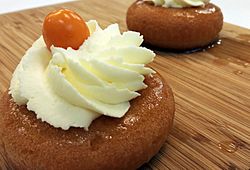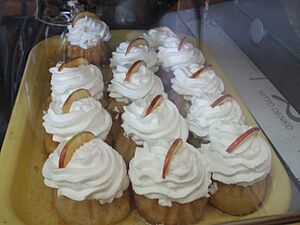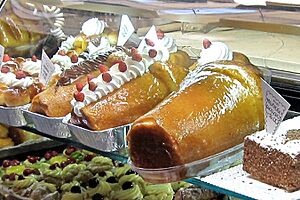Rum baba facts for kids
 |
|
| Type | Cake |
|---|---|
| Place of origin | France |
| Region or state | Lorraine |
| Main ingredients | Eggs, milk, butter, rum |
A rum baba or baba au rhum is a small, sweet cake. It's made with yeast, which helps it rise and become fluffy. This cake is soaked in a sweet syrup, usually flavored with rum. Sometimes, it's also filled with whipped cream or a creamy pastry cream.
Rum babas are often made as individual servings. They are usually about 5 cm tall and shaped like a cylinder. You might also find larger versions, similar to Bundt cakes. The dough for a rum baba is made from simple ingredients like eggs, milk, and butter.
Contents
The Story of the Rum Baba
The rum baba has an interesting history! Its original form was a tall, round yeast cake. This cake was known as baba or babka in many Slavic languages. The word baba means 'old woman' or 'grandmother'. These types of cakes are still popular in countries like Poland, Lithuania, and Ukraine.
The modern baba au rhum, which includes dried fruit and is soaked in rum, was created in Paris, France. This happened around 1835. Today, when people in France and most other places say "baba," they usually mean the rum baba.
How the Baba Came to France
The original baba cake arrived in France in the 18th century. This is often linked to Stanislaus I, who was once the king of Poland. He later became the Duke of Lorraine. One story says that Stanislaus thought of soaking a dry cake, like a Gugelhupf or a baba, in an alcoholic drink.
Another story says that a baba cake Stanislaus brought back from a trip had become dry. Nicolas Stohrer, one of his chefs, found a solution. He added Malaga wine, saffron, dried and fresh raisins, and cream to the cake.
Stohrer later moved to Versailles in 1725. He became the chef for Stanislaus's daughter, Marie Leszczyńska, when she married King Louis XV. Stohrer then opened his own bakery in Paris in 1730.
Adding Rum to the Recipe
One of Stohrer's family members is thought to have first used rum in the baba recipe around 1835. While it's believed they used rum on fresh cakes, today, bakers often let the baba dry a little. This helps the cake soak up the rum syrup even better. Later, the recipe was improved by mixing the rum with a sweet sugar syrup that had extra flavors.
The baba cake is also very popular in Naples, Italy. It became a famous Neapolitan specialty there, known as babà or babbà.
Savarin Cake
In 1844, two bakers in Paris, the Julien Brothers, created the Savarin cake. This cake was inspired by the rum baba. However, the Savarin is soaked in a different alcoholic mixture. It's also baked in a circular or ring-shaped mold, instead of the simple round shape of the baba.
Today, the ring shape is often used for rum babas too. Sometimes, the name Savarin is even used for the rum-soaked cake that has a circular shape.
See also
 In Spanish: Babà para niños
In Spanish: Babà para niños



